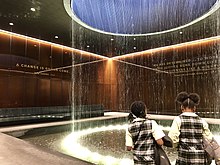National Museum of African American History and Culture
The National Museum of African American History and Culture ( NMAAHC ) is a Smithsonian Institution museum in Washington, DC The museum was founded in 2003 and opened on September 24, 2016. The building was erected on the National Mall in Washington and is dedicated to the culture and history of African American people .
history
The National Museum of African American History and Culture was founded in 2003 by federal law enacted by Congress . The Smithsonian Institution was commissioned to carry it out, and in January 2006 it determined the location of the museum building to be constructed: on Washington's Constitution Avenue between the Washington Monument and the National Museum of American History . The new museum is the 19th museum operated by the institution. As the only national museum in the United States dedicated to African American history and culture, it opened on September 24, 2016 in the presence of President Barack Obama . Construction began in February 2012, and Barack Obama and Barbara Bush gave speeches at the laying of the foundation stone .
Collections
The NMAAHC collections cover the major periods of African American history and origins from Africa; they include the history of slavery, the Reconstruction period , the Harlem Renaissance , the civil rights movement of the 1950s and 1960s, and the 21st century. The exhibits include a .:
- the Harriet Tubman collection, which includes her hymn and a cloak given by Queen Victoria
- a Jim Crow railway wagon (wagon with seats separated by race )
- a red Cadillac convertible made by Chuck Berry (1973)
- the Black Fashion Museum Collection (around 1000 pieces)
- a 1942 PT-13 Stearman training aircraft of the Tuskegee Airmen ( World War II )
- Artwork by Charles Alston , John Biggers , Elizabeth Catlett , Jacob Lawrence , Lorna Simpson , Romare Bearden , Archibald John Motley Jr. , Henry Ossawa Tanner, and Frederick C. Flemister
- Emmett Till's coffin from 1955
- a slave accommodation on Edisto Island ( Sea Islands ) from the first half of the 19th century
- the Selmer trumpet by Louis Armstrong
- Neck irons and shackles of African slaves from a Portuguese ship
Museum building
The building is intended to embody the “African American Spirit” and is based on the division of a classic, three-part column with base, shaft and capital. In the art and architecture of the Yoruba people , a column was closed off by a crown-like capital that is stylized to be found in the floor elements of the new museum that expand upwards. The estimated construction cost will be 500 million US dollars . Half of the costs were borne by donors; In addition to some large donations, there were also many small donations. 60 percent of the exhibition space is underground.
Several architecture studios were involved in the design and execution: The Freelon Group, Adjaye Associates, Davis Brody Bond and the SmithGroup. The lead architects were Philip Freelon and David Adjaye .
In the Beazley Design of the Year 2017 design competition, the Design Museum London named the building both the winner of the architecture category and the overall winner.
Movies
- The Black Museum: A monument to the history and culture of African American people. 52-minute film documentation by Oliver Hardt for ZDF (Germany 2017)
literature
- Lonnie G. Bunch III .: A Fool's Errand: Creating the National Museum of African American History and Culture During the Age of Bush, Obama, and Trump. Smithsonian Institution Scholarly Press, Washington 2019, ISBN 978-1-58834-668-1 .
- Mabel O. Wilson: Begin with the Past: Building the National Museum of African American History and Culture. Smithsonian Institution Scholarly Press, Washington 2016, ISBN 978-1-58834-569-1 .
Web links
References and comments
- ↑ Black pride for all races and classes in FAZ from September 26, 2016, page 11
- ↑ National Museum of African American History and Culture , Newsroom of the Smithsonian (English)
- ↑ Ronald D. Gerste: We are different - We are the same. nzz.ch, September 2, 2016, accessed on September 22, 2016
- ^ Philip Kennicott: The African American Museum a year later: Still the hottest ticket in town. In: The Washington Post. September 22, 2017, accessed on September 23, 2017 .
- ↑ Beyond their dreams: Washington gets a new museum , April 15, 2009, BauNetz
- ↑ Hanno Rauterberg: And facing the sky. zeit.de, September 22, 2016, accessed on September 22, 2016
- ^ Susanne Güsten: First museum for African American history. tagesspiegel.de, September 16, 2016, accessed on September 22, 2016
Coordinates: 38 ° 53 '27.6 " N , 77 ° 1' 57.4" W.


